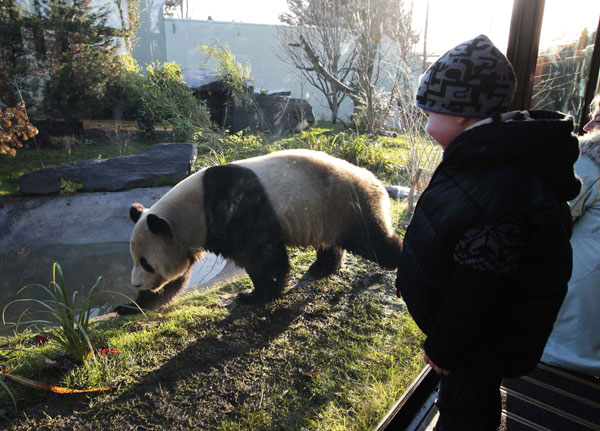
Yang Guang draws attention as he explores his new enclosure at Edinburgh Zoo at a preview on Dec 12. (Photo: Reuters)
Stress of flying
Among all factors that would stress the pandas, long-distance travel is the most significant, saidLi Mingxi, an expert at the Chengdu base.
In September 2007, Li and a colleague escorted pandas Bing Xing and Hua Zuiba to Madrid Zooin Spain. They took off in Chengdu on a TNT cargo aircraft for a transfer in Shanghai.
Because they had already cleared customs in Chengdu, they could not leave the Shanghaiairport. The Chinese experts put the caged pandas in a relatively quiet corner of the freight yard, but the loud noises of cargo loading and planes taking off and landing disturbed the animals.
Bing Xing and Hua Zuiba became nervous and restless, pacing their cages for half the night. Liand his colleague were prepared, with 200 kg of fresh bamboo shoots. The food comforted thepandas, and they fell asleep around 4 am. They took off for Madrid a few hours later.
After more than 30 hours of travel, the pair finally arrived at the zoo. The passageways were too narrow, so a crane was used to lift them into their outdooractivity fields. From there, the pandas moved to theindoor enclosures.
Hua Zuiba remained nervous for several months. Sheclasped her limbs tightly even when she was eating, rather than spreading out her arms and legscomfortably.
"Transportation - especially transfer - has a hugeimpact on pandas," Li said. "If we take a direct flight, itwill be much less stressful. The more twists and turnsthey experience, the louder noises they suffer, thebigger the impact.
"In an ideal world, pandas should be closed from thepublic upon their arrival in another country and notreceive any form of visit, reception or interview. Afterseveral days of rest, they will adapt to the newenvironment very quickly," he said.
Custom containers
The cages for panda transportation are speciallydesigned and, usually, are made by panda experts. Inthe case of Bing Xing and Hua Zuiba, the pair bound forMadrid, the Chinese experts sealed three sides of thecage with steel plates to prevent people from havingcontact with the animals and provided many holes onthe side plates for ventilation.
For Wang Wang and Funi's trip to Australia, the cage made in China was 1.66 meters long, 1.2 meters high and 1 meter wide. Its main frame was steel, while its baseboard was plastic forwarmth. The light inside the cage was kept low to quiet the pandas.
People could not touch the pandas from the outside, nor could the pandas reach out to injurepeople. Animal keepers and veterinarians could watch the animals at any time from anobservation hole that was convenient to open and close. A tray was installed at the bottom of thecage to collect urine, which was soaked up by absorbent material.
Sometimes, containers provided by well-known shipping companies are used for pandatransportation.
Tian Tian and Yang Guang traveled in two custom-built containers provided by FedEx Express, which flew the pandas nonstop from Chengdu to Edinburgh on a chartered Boeing 777F, a flightcalled the FedEx Panda Express. Such containers will also be used to send the pandas toFrance, Li said.

Copyright ©1999-2011 Chinanews.com. All rights reserved.
Reproduction in whole or in part without permission is prohibited.